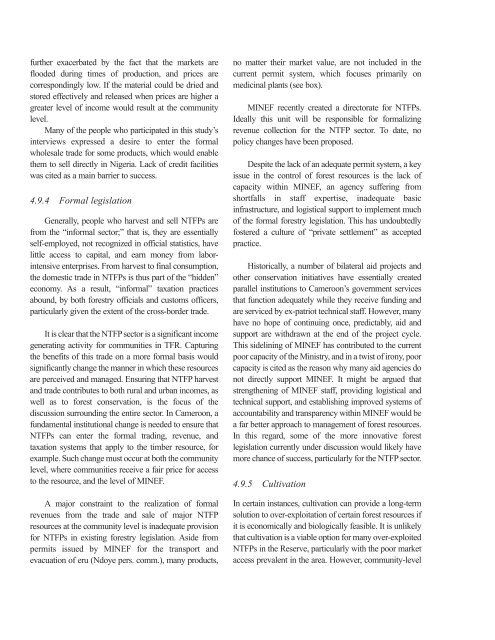Fisheries in the Southern Border Zone of Takamanda - Impact ...
Fisheries in the Southern Border Zone of Takamanda - Impact ...
Fisheries in the Southern Border Zone of Takamanda - Impact ...
Create successful ePaper yourself
Turn your PDF publications into a flip-book with our unique Google optimized e-Paper software.
fur<strong>the</strong>r exacerbated by <strong>the</strong> fact that <strong>the</strong> markets are<br />
flooded dur<strong>in</strong>g times <strong>of</strong> production, and prices are<br />
correspond<strong>in</strong>gly low. If <strong>the</strong> material could be dried and<br />
stored effectively and released when prices are higher a<br />
greater level <strong>of</strong> <strong>in</strong>come would result at <strong>the</strong> community<br />
level.<br />
Many <strong>of</strong> <strong>the</strong> people who participated <strong>in</strong> this study’s<br />
<strong>in</strong>terviews expressed a desire to enter <strong>the</strong> formal<br />
wholesale trade for some products, which would enable<br />
<strong>the</strong>m to sell directly <strong>in</strong> Nigeria. Lack <strong>of</strong> credit facilities<br />
was cited as a ma<strong>in</strong> barrier to success.<br />
4.9.4 Formal legislation<br />
Generally, people who harvest and sell NTFPs are<br />
from <strong>the</strong> “<strong>in</strong>formal sector;” that is, <strong>the</strong>y are essentially<br />
self-employed, not recognized <strong>in</strong> <strong>of</strong>ficial statistics, have<br />
little access to capital, and earn money from labor<strong>in</strong>tensive<br />
enterprises. From harvest to f<strong>in</strong>al consumption,<br />
<strong>the</strong> domestic trade <strong>in</strong> NTFPs is thus part <strong>of</strong> <strong>the</strong> “hidden”<br />
economy. As a result, “<strong>in</strong>formal” taxation practices<br />
abound, by both forestry <strong>of</strong>ficials and customs <strong>of</strong>ficers,<br />
particularly given <strong>the</strong> extent <strong>of</strong> <strong>the</strong> cross-border trade.<br />
It is clear that <strong>the</strong> NTFP sector is a significant <strong>in</strong>come<br />
generat<strong>in</strong>g activity for communities <strong>in</strong> TFR. Captur<strong>in</strong>g<br />
<strong>the</strong> benefits <strong>of</strong> this trade on a more formal basis would<br />
significantly change <strong>the</strong> manner <strong>in</strong> which <strong>the</strong>se resources<br />
are perceived and managed. Ensur<strong>in</strong>g that NTFP harvest<br />
and trade contributes to both rural and urban <strong>in</strong>comes, as<br />
well as to forest conservation, is <strong>the</strong> focus <strong>of</strong> <strong>the</strong><br />
discussion surround<strong>in</strong>g <strong>the</strong> entire sector. In Cameroon, a<br />
fundamental <strong>in</strong>stitutional change is needed to ensure that<br />
NTFPs can enter <strong>the</strong> formal trad<strong>in</strong>g, revenue, and<br />
taxation systems that apply to <strong>the</strong> timber resource, for<br />
example. Such change must occur at both <strong>the</strong> community<br />
level, where communities receive a fair price for access<br />
to <strong>the</strong> resource, and <strong>the</strong> level <strong>of</strong> MINEF.<br />
A major constra<strong>in</strong>t to <strong>the</strong> realization <strong>of</strong> formal<br />
revenues from <strong>the</strong> trade and sale <strong>of</strong> major NTFP<br />
resources at <strong>the</strong> community level is <strong>in</strong>adequate provision<br />
for NTFPs <strong>in</strong> exist<strong>in</strong>g forestry legislation. Aside from<br />
permits issued by MINEF for <strong>the</strong> transport and<br />
evacuation <strong>of</strong> eru (Ndoye pers. comm.), many products,<br />
no matter <strong>the</strong>ir market value, are not <strong>in</strong>cluded <strong>in</strong> <strong>the</strong><br />
current permit system, which focuses primarily on<br />
medic<strong>in</strong>al plants (see box).<br />
MINEF recently created a directorate for NTFPs.<br />
Ideally this unit will be responsible for formaliz<strong>in</strong>g<br />
revenue collection for <strong>the</strong> NTFP sector. To date, no<br />
policy changes have been proposed.<br />
Despite <strong>the</strong> lack <strong>of</strong> an adequate permit system, a key<br />
issue <strong>in</strong> <strong>the</strong> control <strong>of</strong> forest resources is <strong>the</strong> lack <strong>of</strong><br />
capacity with<strong>in</strong> MINEF, an agency suffer<strong>in</strong>g from<br />
shortfalls <strong>in</strong> staff expertise, <strong>in</strong>adequate basic<br />
<strong>in</strong>frastructure, and logistical support to implement much<br />
<strong>of</strong> <strong>the</strong> formal forestry legislation. This has undoubtedly<br />
fostered a culture <strong>of</strong> “private settlement” as accepted<br />
practice.<br />
Historically, a number <strong>of</strong> bilateral aid projects and<br />
o<strong>the</strong>r conservation <strong>in</strong>itiatives have essentially created<br />
parallel <strong>in</strong>stitutions to Cameroon’s government services<br />
that function adequately while <strong>the</strong>y receive fund<strong>in</strong>g and<br />
are serviced by ex-patriot technical staff. However, many<br />
have no hope <strong>of</strong> cont<strong>in</strong>u<strong>in</strong>g once, predictably, aid and<br />
support are withdrawn at <strong>the</strong> end <strong>of</strong> <strong>the</strong> project cycle.<br />
This sidel<strong>in</strong><strong>in</strong>g <strong>of</strong> MINEF has contributed to <strong>the</strong> current<br />
poor capacity <strong>of</strong> <strong>the</strong> M<strong>in</strong>istry, and <strong>in</strong> a twist <strong>of</strong> irony, poor<br />
capacity is cited as <strong>the</strong> reason why many aid agencies do<br />
not directly support MINEF. It might be argued that<br />
streng<strong>the</strong>n<strong>in</strong>g <strong>of</strong> MINEF staff, provid<strong>in</strong>g logistical and<br />
technical support, and establish<strong>in</strong>g improved systems <strong>of</strong><br />
accountability and transparency with<strong>in</strong> MINEF would be<br />
a far better approach to management <strong>of</strong> forest resources.<br />
In this regard, some <strong>of</strong> <strong>the</strong> more <strong>in</strong>novative forest<br />
legislation currently under discussion would likely have<br />
more chance <strong>of</strong> success, particularly for <strong>the</strong> NTFP sector.<br />
4.9.5 Cultivation<br />
In certa<strong>in</strong> <strong>in</strong>stances, cultivation can provide a long-term<br />
solution to over-exploitation <strong>of</strong> certa<strong>in</strong> forest resources if<br />
it is economically and biologically feasible. It is unlikely<br />
that cultivation is a viable option for many over-exploited<br />
NTFPs <strong>in</strong> <strong>the</strong> Reserve, particularly with <strong>the</strong> poor market<br />
access prevalent <strong>in</strong> <strong>the</strong> area. However, community-level

















